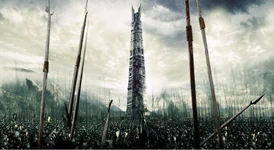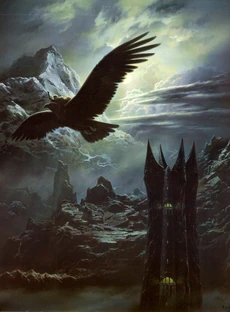Orthanc was the black, impenetrable tower of Isengard built by the Dúnedain. By the Great Years and the War of the Ring, it was controlled by the wizard Saruman the White. It stood in the center of the Ring of Isengard, surrounded by great defensive walls fortified by the early Men of Gondor.
Description
- "A great ring-wall of stone, like towering cliffs, stood out from the shelter of the mountain-side, from which it ran and then returned again... one who passed in and came at length out of the echoing tunnel, beheld a plain, a great circle, somewhat hollowed like a vast shallow bowl: a mile it measured from rim to rim. Once it had been green and filled with avenues, and groves of fruitful trees, watered by streams that flowed from the mountains to a lake. But no green thing grew there in the latter days of Saruman. The roads were paved with stone-flags dark and hard; and beside their borders instead of trees there marched long lines of pillars, some of marble, some of copper and of iron, joined by heavy chains, to the centre all the roads ran between their chains. There stood a tower of marvelous shape. It was fashioned by the builders of old, who smoothed the Ring of Isengard, and yet it seemed a thing not made by the craft of Men, but riven from the bones of the earth in the ancient torment of the hills. A peak and isle of rock it was, black and gleaming hard: four mighty piers of many-sided stone were welded into one, but near the summit they opened into gaping horns, their pinnacles sharp as the points of spears, keen-edged as knives. Between them was a narrow space, and there upon a floor of polished stone, written with strange signs, a man might stand five hundred feet above the plain."
- —The tower as described by J.R.R. Tolkien
The tower was constructed out of four piers of stone and then hardened by an unknown process. No weaponry or magic that existed on Arda was known to be able to harm it. Until the Ents that besieged Isengard during the War of the Ring managed to inflict slight damage on the tower, but their efforts ultimately proved to be futile. When Grima Wormtongue later threw the palantir of Orthanc from a high window, it fell on the stairs, causing the rail to snap and part of the staircase to break.
The only entrance to the tower was reached by a stair of twenty-seven steps, the door could only be opened with the Keys of Orthanc. Above the door there was a balcony, and many tall windows higher up.[citation needed]
History
Second Age

Isengard
The exact date of construction of Orthanc and establishment of Isengard is unknown; however it must have been built between SA 3320, the time of the establishment of Arnor and Gondor, and SA 3430, when the Last Alliance of Elves and Men was formed. Within the fortified walls of the tower was placed one of the Palantíri, the Stone of Orthanc. Thus, Orthanc was now known as one of the seven towers of the Dúnedain, housing the seventh seeing stone brought back from Númenor by Elendil.
Third Age
Orthanc suffered greatly during the Great Plague of TA 1636, and many of the Númenóreans that inhabited it gradually migrated eastward. Eventually the tower itself became deserted and its keys being moved to Minas Tirith to be kept by the Stewards of Gondor.
After the Battle of the Field of Celebrant in TA 2510, a small group of Men of Gondor travelled to Isengard and maintained the fortress on their own. However, the Keys of Orthanc still officially belonged to the Stewards of Gondor.
Over time, Orthanc lost its connections with Minas Tirith and the Men of Gondor failed to maintain the tower successfully. The Dunlendings then took over the fortress and launched many attacks on the Westfold. In the Long Winter of TA 2754, the Dunlendings were eventually starved out due to the famine caused by the lack of communication to all food suppliers. Then Saruman put in an offer for the control of Isengard and both King Fréaláf and Steward Beren embraced the proposition with open arms. Thus, the wizard was handed the keys to Orthanc.

Saruman and the Stone of Orthanc
After gaining the control of Isengard, Saruman became greatly interested in the Rings of Power and began to especially desire the One. He thought that if he gave time for Sauron to regain some strength, the ring would reveal itself to him. Therefore, as head of the White Council, Saruman overruled Gandalf's call for an attack on Dol Guldur, the Dark Lord's then current fortress. However in TA 2941, he did agree on the attack when he found out that the servants of Sauron were searching for the ring near the Gladden Fields.[citation needed]

Gandalf's Rescuer
Later, Saruman's mind was corrupted and fell under the control of Sauron when he used the Stone of Orthanc—the seventh Palantiri—for the first time.
In TA 3018, Gandalf rode to Isengard to meet with Saruman. It was then that the wizard declared his true thoughts regarding his desire to be ruler of Men, to possess the Ring, and to join Sauron in his evil deeds. Gandalf refused Saruman's offer to join him and Sauron. Subsequently, the wizard held Gandalf captive on Orthanc's pinnacle until he submitted in telling the location of the One Ring. After many weeks of imprisonment, Gwaihir, the Lord of the Eagles, came unlooked for and bore him away.
Only months later, the Ents of Fangorn Forest launched their attack on Isengard. By the next day, only the tower of Orthanc remained, as it was hewn of one piece of impenetrable rock, and the plains below had been completely destroyed, leaving a desolate land of water and mud. Three days after the battle, Theoden, Éomer, Gandalf, Aragorn, Legolas, and Gimli approached Orthanc past a desolation of wreckage caused by the Ents including a huge blood-ridden white hand, and climbed its stair. They parleyed with Saruman, who remained inside the tower and spoke to them from a balcony above the door. After Saruman refused to cooperate and attempted to control the Rohirrim riding with them, Gandalf cast him from the Order of Wizards and the White Council, breaking Saruman's Staff. After the confrontation, Grima Wormtongue—who was inside the tower at the time—threw the Stone of Orthanc at the party outside as a parting shot.[citation needed]
Fourth Age

Battle of Isengard
One of King Elessar's first tasks he had set was the restoration of Orthanc. He ordered that the Palantir should be recovered and returned to the tower. Then Orthanc was searched and many secrets were revealed. It was clear that Saruman had been hoarding many ancient treasures and heirlooms during his time there. With the aid of Wormtongue, Saruman had acquired many jewels and heirlooms belonging to Eorl. Soon a hidden door was found and inside a casket they found two precious objects: one of which was a small gold case attached to a chain - this was used by Isildur to bear the One Ring; and second of which was the Elendilmir - the 'white star of Elvish crystal upon a fillet of mithril' that had been lost since Isildur's demise. Elessar received the Elendilmir with reverence and took it with him as he established his full kingship of Arnor. It was revealed that Saruman had found the remains of Isildur and had burned them.
Orthanc and the plains of Isengard around it remained part of the Reunited Kingdom of Arnor and Gondor. However, King Elessar granted the Ents complete self-governance of the area surrounding the tower. This new forest became known as the Treegarth of Orthanc.[citation needed]
Pinnacle of Orthanc

Orthanc roof sign
The Pinnacle of Orthanc was the summit of Saruman's tower. Its corners were razor-edged points with room for at least two men to stand. It was accessed by a flight of thousands of stairs, which Saruman would use to reach the top and observe the stars.
It was here where Saruman imprisoned Gandalf at the start of the War of the Ring, which caused him to be delayed in meeting with Frodo. He was rescued by the Great Eagle Gwaihir, sent by Radagast the Brown.[citation needed]
Etymology
According to Tolkien, its name is both Sindarin for "Mount Fang", and Rohirric for "Cunning Mind". The latter is more likely to be its real meaning, as the word Orthanc is a real Old English word (Old English being the linguistic basis for Rohirric); the Sindarin name being no more than a poetic coincidence. In Old English, Orþanc means "cunning device", but Tolkien has said this is merely a coincidence.[citation needed]
Translations around the world
| Foreign Language | Translated name |
|---|---|
| Amharic | ዖርትሃንች |
| Arabic | اورثانك |
| Armenian | Որտհանծ |
| Belarusian Cyrillic | Артханк |
| Bengali | অর্থনকে |
| Bulgarian Cyrillic | Ортанк |
| Catalan | Òrthanc |
| Chinese (Hong Kong) | 歐散克塔 |
| Georgian | ორთჰანჩ |
| Greek | Ορθανκ |
| Gujarati | ઑર્થન્ચ |
| Hebrew | ארתנק |
| Hindi | ऑर्थैंक |
| Japanese | オルサンク |
| Kannada | ಒರ್ಥನ್ಚ್ |
| Kazakh | Ортһанц (Cyrillic) Orthanc (Latin) |
| Kyrgyz Cyrillic | Ортhанц |
| Lao | ອrຕຫະນຈ ? |
| Macedonian Cyrillic | Ортханц |
| Mongolian Cyrillic | Ортhанц ? |
| Nepalese | ॐर्थन्च |
| Pashto | ورتهانچ |
| Persian | اورتانک |
| Polish | Orthank |
| Russian | Ортанк |
| Sanskrit | ॐर्थन्च् |
| Serbian | Ортанк (Cyrillic) Ortank (Latin) |
| Sinhalese | ඕර්ථන්ච් |
| Slovak | Orthank |
| Tajik Cyrillic | Ортҳанч |
| Tamil | ஓர்த்ஹந்ச் |
| Telugu | ఓర్థన్చ |
| Thai | ออร์ธังค์ |
| Turkish | Ortank |
| Ukrainian Cyrillic | Ортханк |
| Urdu | ارٹہانک |
| Uzbek | Ортҳанч (Cyrillic) Orthanc (Latin) |
| Yiddish | אָרטהאַנק |
